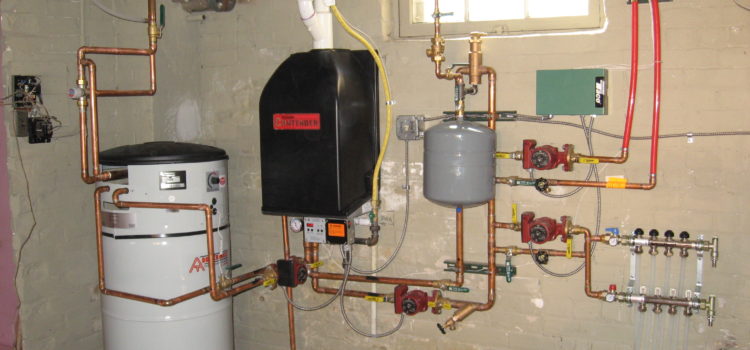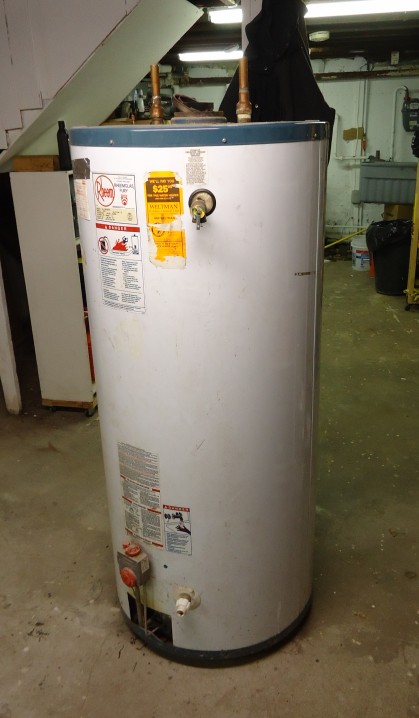
Summary
– Instantaneous domestic hot water
– Domestic hot water by the storage tank
Instantaneous domestic hot water
Domestic water flows through a coil or plate heat exchanger located in the heating element. The opening of a hot water tap closes a vacuum contactor, usually resulting in :
– The burner (or resistors) is ignited and transmits its calories to the domestic water through the exchanger;
– the heating circuit may be temporarily stopped to devote all the available energy to heat the domestic water.
Closing the tap restores the previous situation.
Advantages of instant hot water
Having instant hot water available has several advantages:
– Hot water is available without limit of quantity, as soon as the boiler is switched on.
– There is no energy consumption if there is no water drawn, and it allows little heat loss.
– This system is economical to operate and purchase.
– The generator is not very bulky.
– There is no safety group on the hot water circuit.
Instantaneous hot water: its disadvantages
Quick hot water production is incompatible with low-temperature generators, solar or heat pumps:
The boiler’s power must be oversized because the production of DHW requires a significant input of calories in a short period.
– The water flow rate is proportional to the generator’s power and the output temperature but is limited in all cases (11 to 14 liters per minute on average).
– Instantaneous hot water has a comfort deficit: random temperature stability (although in clear progress in recent models), too long bathtub filling time, impossibility to supply several drawing points without a drop in flow rate and temperature.
Note: instantaneous hot water production is a virtual monopoly of wall-mounted boilers running on gas and electricity.
Domestic hot water by the storage tank

Domestic water is heated in contact with a heat transfer fluid (or a resistor), which circulates in a coil or plate heat exchanger located in the storage tank:
– The thermostat cuts off the circulation of the heat transfer fluid (or resistance) when the water volume reaches the set temperature.
– It will maintain this temperature by an opening/closing mechanism after each drawdown.
Most floor-standing boilers and some wall-mounted boilers are available with an integrated storage tank, but it can also be completely independent.
Advantages of an accumulator hot water tank
It is very comfortable to use:
– Hot water is immediately available in large quantities.
– The flow rate is regular, even during peak demand, and the water temperature remains stable.
– The number of drawing stations is unlimited.
– It allows operating savings (except for electric cumulus, despite the off-peak rate).
– The storage tank is compatible with all energies, including solar, heat pumps, geothermal, etc.
– There is little or no impact on the boiler output.
– Its operation is smooth, so the longevity of the equipment is increased.
What are the disadvantages?
Let’s take a closer look at the disadvantages of the storage tank:
– Its temperature rise is long.
– The quantity of hot water is limited to the volume of the tank.
– Its size and weight are essential.
– Heat losses from storage are present (despite progress in insulation).
– The investment and installation costs are high (except for the electric cumulus).
– There is an increased risk of bacterial infection.
Alternatives to the hot water tank
More and more manufacturers are ingeniously proposing intermediate solutions, for example :
The plate heat exchanger is an alternative to the instantaneous system:
– This space-saving and economic system is integrated into a boiler or independent.
– It can be freed from a tank but can also be integrated into it, reducing its volume and space requirement.
Micro-accumulation is a buffer tank system with a minimal capacity (one to a few liters) maintained at temperature by electric resistance. This device eliminates the usual waiting time for instantaneous systems.
The thermodynamic water heater recovers calories from the ambient air using a dedicated integrated heat pump :
– The heat thus produced is transmitted to the water in the tank through an exchanger.
The equipment’s investment is higher, but the operating costs are 2 to 3 times lower than with fossil energy or electricity.
Instantaneous hot water or storage tank: what are the rates?
The prices of a water heater vary greatly, depending on its technology and its degree of autonomy.
For an individual house :
– An instantaneous gas or electric water heater costs between $500 and $1,500, including installation.
– A thermodynamic water heater costs between $2,500 and $3,500.
– A solar water heater with a 300-liter tank can cost between $3,000 and $5,000, depending on the installation difficulties.


Pingback:How to Plan the Design and Layout of Your Bathroom | MyHome